Early Childhood Development Assignment: Key Concepts Explored
VerifiedAdded on 2022/08/14
|6
|1385
|13
Homework Assignment
AI Summary
This assignment delves into the intricate processes of early childhood development, focusing on three key areas: the development of a child's attachment, the formation of a sense of self, and the impact of family and Early Learning and Child Care (ELCC) professionals on a child's social and emotional growth. The first section defines attachment as a crucial emotional bond, exploring its stages and variations, including secure and insecure attachment styles. The second section examines the emergence of self-concept, highlighting the role of temperament, physical health, and moral understanding in shaping a child's sense of identity. The final section analyzes the influence of family and ELCC professionals, emphasizing their roles in fostering social skills, emotional well-being, and overall holistic development in children, including the importance of caregiver-child relationships. The assignment draws on various research to support its findings.
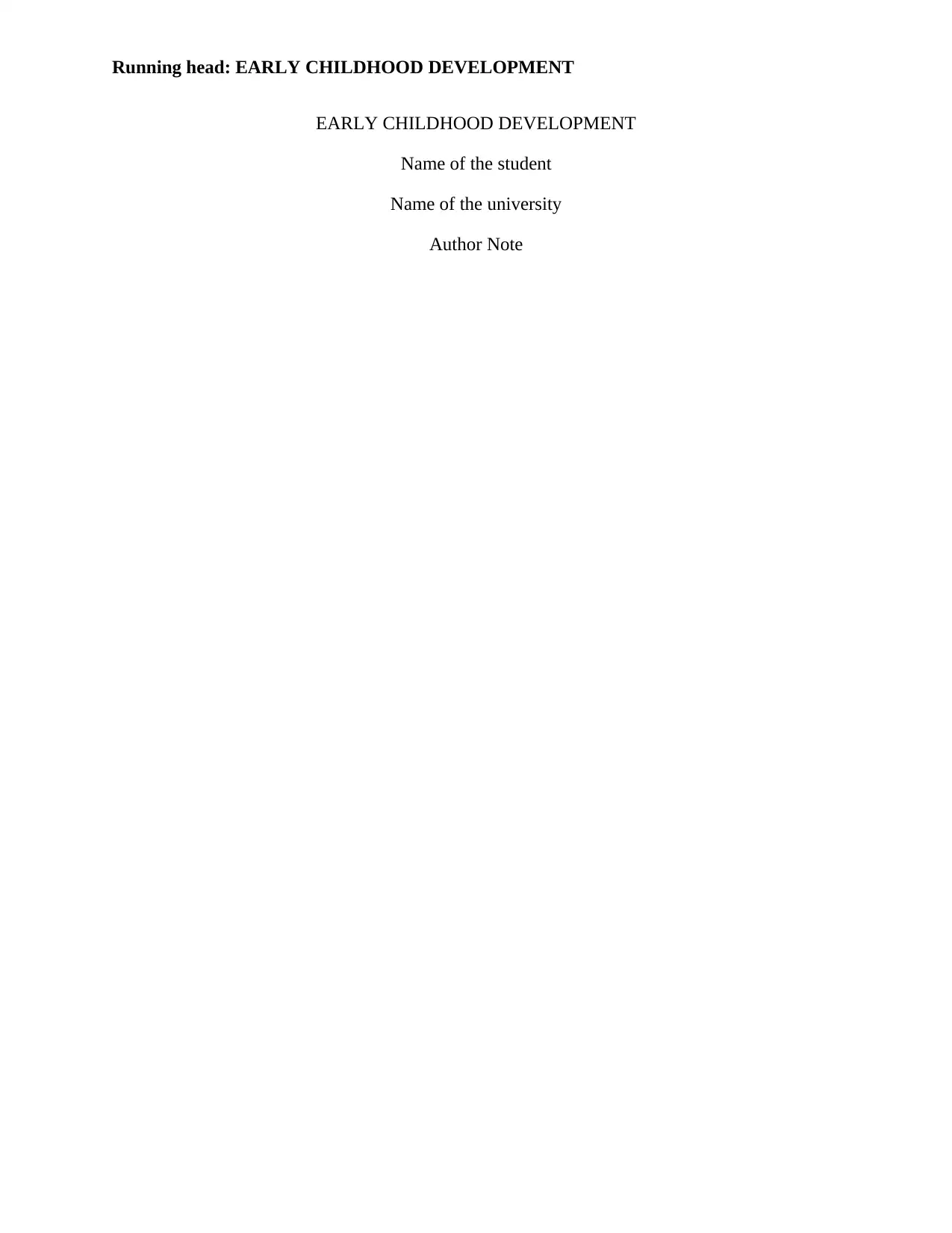
Running head: EARLY CHILDHOOD DEVELOPMENT
EARLY CHILDHOOD DEVELOPMENT
Name of the student
Name of the university
Author Note
EARLY CHILDHOOD DEVELOPMENT
Name of the student
Name of the university
Author Note
Paraphrase This Document
Need a fresh take? Get an instant paraphrase of this document with our AI Paraphraser
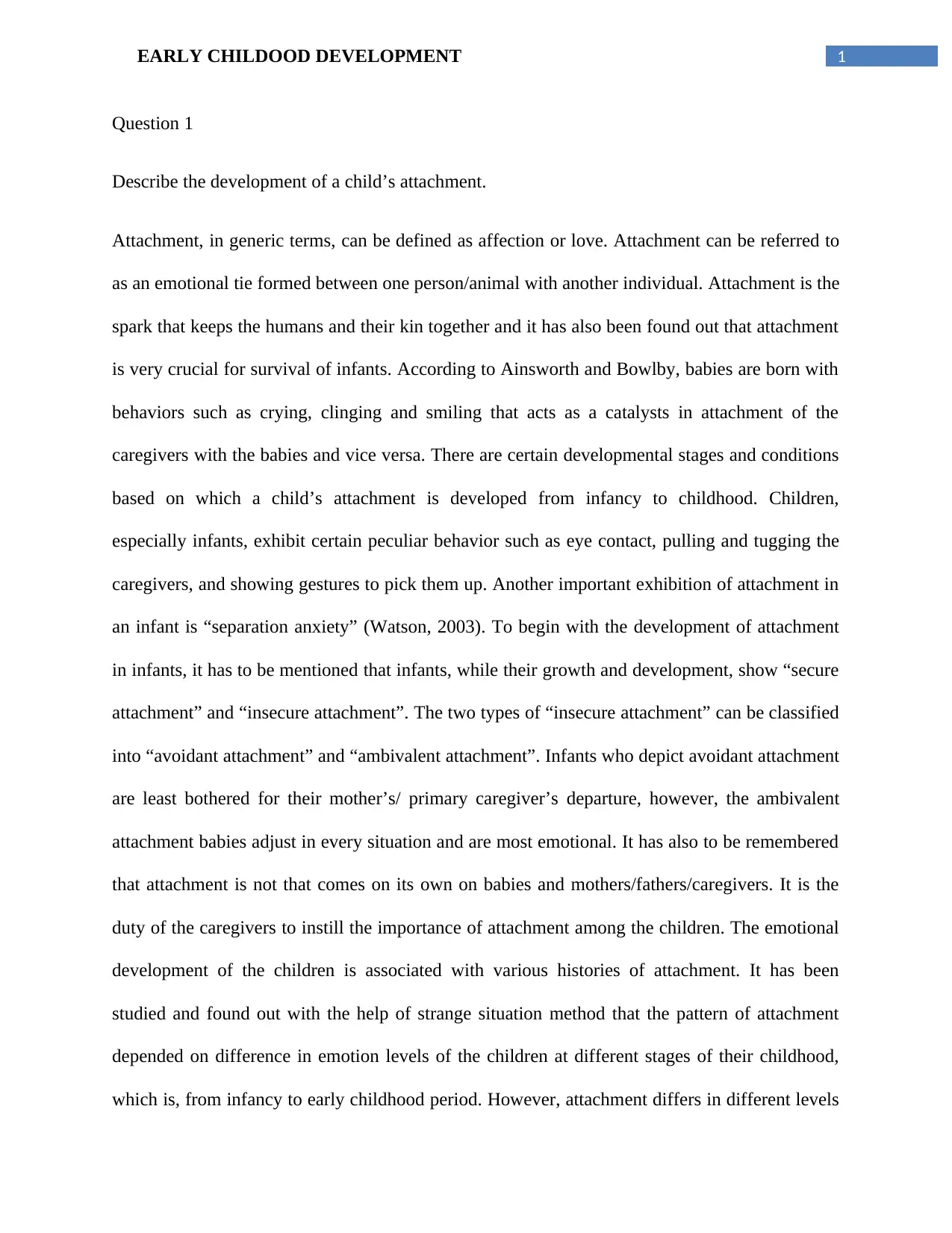
1EARLY CHILDOOD DEVELOPMENT
Question 1
Describe the development of a child’s attachment.
Attachment, in generic terms, can be defined as affection or love. Attachment can be referred to
as an emotional tie formed between one person/animal with another individual. Attachment is the
spark that keeps the humans and their kin together and it has also been found out that attachment
is very crucial for survival of infants. According to Ainsworth and Bowlby, babies are born with
behaviors such as crying, clinging and smiling that acts as a catalysts in attachment of the
caregivers with the babies and vice versa. There are certain developmental stages and conditions
based on which a child’s attachment is developed from infancy to childhood. Children,
especially infants, exhibit certain peculiar behavior such as eye contact, pulling and tugging the
caregivers, and showing gestures to pick them up. Another important exhibition of attachment in
an infant is “separation anxiety” (Watson, 2003). To begin with the development of attachment
in infants, it has to be mentioned that infants, while their growth and development, show “secure
attachment” and “insecure attachment”. The two types of “insecure attachment” can be classified
into “avoidant attachment” and “ambivalent attachment”. Infants who depict avoidant attachment
are least bothered for their mother’s/ primary caregiver’s departure, however, the ambivalent
attachment babies adjust in every situation and are most emotional. It has also to be remembered
that attachment is not that comes on its own on babies and mothers/fathers/caregivers. It is the
duty of the caregivers to instill the importance of attachment among the children. The emotional
development of the children is associated with various histories of attachment. It has been
studied and found out with the help of strange situation method that the pattern of attachment
depended on difference in emotion levels of the children at different stages of their childhood,
which is, from infancy to early childhood period. However, attachment differs in different levels
Question 1
Describe the development of a child’s attachment.
Attachment, in generic terms, can be defined as affection or love. Attachment can be referred to
as an emotional tie formed between one person/animal with another individual. Attachment is the
spark that keeps the humans and their kin together and it has also been found out that attachment
is very crucial for survival of infants. According to Ainsworth and Bowlby, babies are born with
behaviors such as crying, clinging and smiling that acts as a catalysts in attachment of the
caregivers with the babies and vice versa. There are certain developmental stages and conditions
based on which a child’s attachment is developed from infancy to childhood. Children,
especially infants, exhibit certain peculiar behavior such as eye contact, pulling and tugging the
caregivers, and showing gestures to pick them up. Another important exhibition of attachment in
an infant is “separation anxiety” (Watson, 2003). To begin with the development of attachment
in infants, it has to be mentioned that infants, while their growth and development, show “secure
attachment” and “insecure attachment”. The two types of “insecure attachment” can be classified
into “avoidant attachment” and “ambivalent attachment”. Infants who depict avoidant attachment
are least bothered for their mother’s/ primary caregiver’s departure, however, the ambivalent
attachment babies adjust in every situation and are most emotional. It has also to be remembered
that attachment is not that comes on its own on babies and mothers/fathers/caregivers. It is the
duty of the caregivers to instill the importance of attachment among the children. The emotional
development of the children is associated with various histories of attachment. It has been
studied and found out with the help of strange situation method that the pattern of attachment
depended on difference in emotion levels of the children at different stages of their childhood,
which is, from infancy to early childhood period. However, attachment differs in different levels
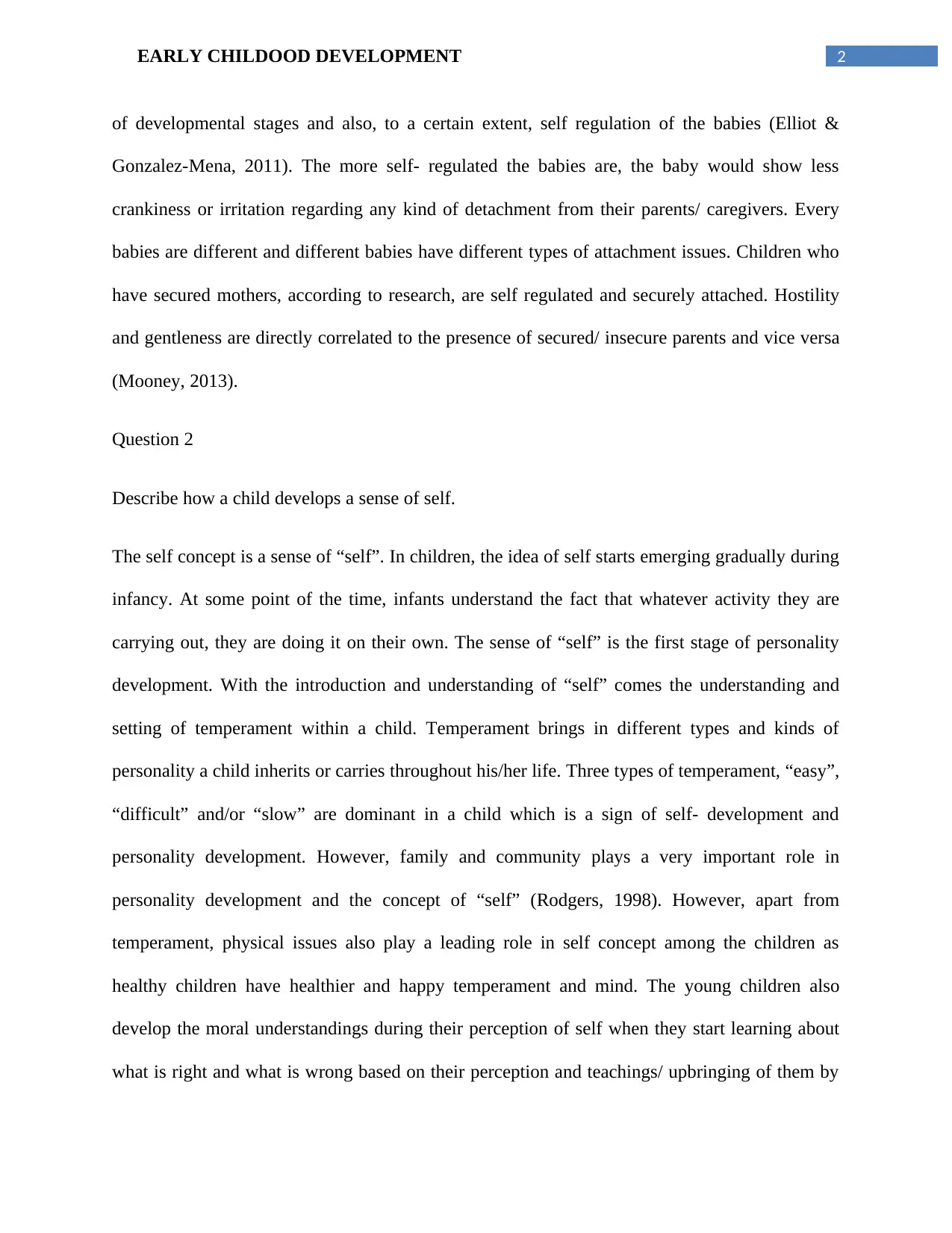
2EARLY CHILDOOD DEVELOPMENT
of developmental stages and also, to a certain extent, self regulation of the babies (Elliot &
Gonzalez-Mena, 2011). The more self- regulated the babies are, the baby would show less
crankiness or irritation regarding any kind of detachment from their parents/ caregivers. Every
babies are different and different babies have different types of attachment issues. Children who
have secured mothers, according to research, are self regulated and securely attached. Hostility
and gentleness are directly correlated to the presence of secured/ insecure parents and vice versa
(Mooney, 2013).
Question 2
Describe how a child develops a sense of self.
The self concept is a sense of “self”. In children, the idea of self starts emerging gradually during
infancy. At some point of the time, infants understand the fact that whatever activity they are
carrying out, they are doing it on their own. The sense of “self” is the first stage of personality
development. With the introduction and understanding of “self” comes the understanding and
setting of temperament within a child. Temperament brings in different types and kinds of
personality a child inherits or carries throughout his/her life. Three types of temperament, “easy”,
“difficult” and/or “slow” are dominant in a child which is a sign of self- development and
personality development. However, family and community plays a very important role in
personality development and the concept of “self” (Rodgers, 1998). However, apart from
temperament, physical issues also play a leading role in self concept among the children as
healthy children have healthier and happy temperament and mind. The young children also
develop the moral understandings during their perception of self when they start learning about
what is right and what is wrong based on their perception and teachings/ upbringing of them by
of developmental stages and also, to a certain extent, self regulation of the babies (Elliot &
Gonzalez-Mena, 2011). The more self- regulated the babies are, the baby would show less
crankiness or irritation regarding any kind of detachment from their parents/ caregivers. Every
babies are different and different babies have different types of attachment issues. Children who
have secured mothers, according to research, are self regulated and securely attached. Hostility
and gentleness are directly correlated to the presence of secured/ insecure parents and vice versa
(Mooney, 2013).
Question 2
Describe how a child develops a sense of self.
The self concept is a sense of “self”. In children, the idea of self starts emerging gradually during
infancy. At some point of the time, infants understand the fact that whatever activity they are
carrying out, they are doing it on their own. The sense of “self” is the first stage of personality
development. With the introduction and understanding of “self” comes the understanding and
setting of temperament within a child. Temperament brings in different types and kinds of
personality a child inherits or carries throughout his/her life. Three types of temperament, “easy”,
“difficult” and/or “slow” are dominant in a child which is a sign of self- development and
personality development. However, family and community plays a very important role in
personality development and the concept of “self” (Rodgers, 1998). However, apart from
temperament, physical issues also play a leading role in self concept among the children as
healthy children have healthier and happy temperament and mind. The young children also
develop the moral understandings during their perception of self when they start learning about
what is right and what is wrong based on their perception and teachings/ upbringing of them by
⊘ This is a preview!⊘
Do you want full access?
Subscribe today to unlock all pages.

Trusted by 1+ million students worldwide
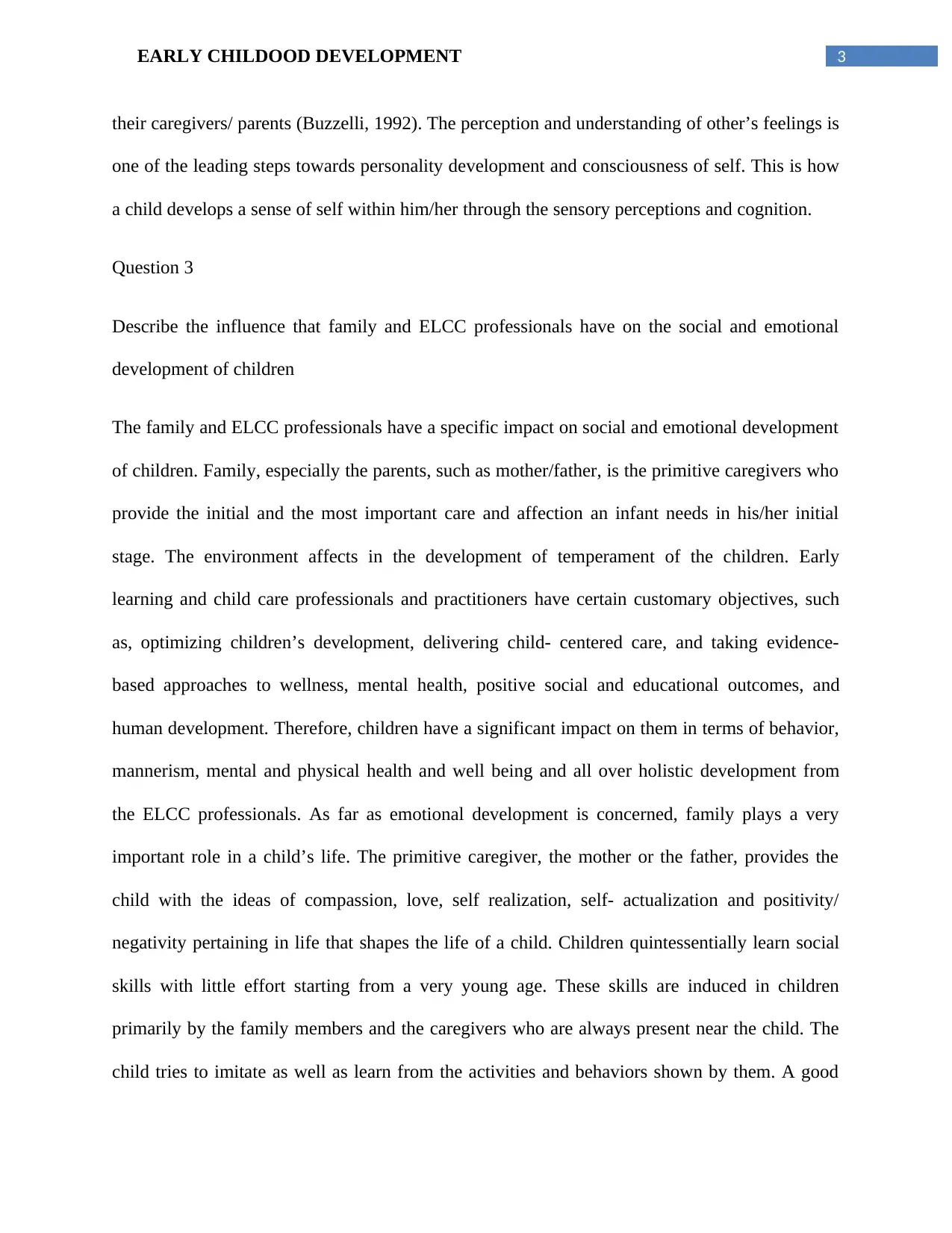
3EARLY CHILDOOD DEVELOPMENT
their caregivers/ parents (Buzzelli, 1992). The perception and understanding of other’s feelings is
one of the leading steps towards personality development and consciousness of self. This is how
a child develops a sense of self within him/her through the sensory perceptions and cognition.
Question 3
Describe the influence that family and ELCC professionals have on the social and emotional
development of children
The family and ELCC professionals have a specific impact on social and emotional development
of children. Family, especially the parents, such as mother/father, is the primitive caregivers who
provide the initial and the most important care and affection an infant needs in his/her initial
stage. The environment affects in the development of temperament of the children. Early
learning and child care professionals and practitioners have certain customary objectives, such
as, optimizing children’s development, delivering child- centered care, and taking evidence-
based approaches to wellness, mental health, positive social and educational outcomes, and
human development. Therefore, children have a significant impact on them in terms of behavior,
mannerism, mental and physical health and well being and all over holistic development from
the ELCC professionals. As far as emotional development is concerned, family plays a very
important role in a child’s life. The primitive caregiver, the mother or the father, provides the
child with the ideas of compassion, love, self realization, self- actualization and positivity/
negativity pertaining in life that shapes the life of a child. Children quintessentially learn social
skills with little effort starting from a very young age. These skills are induced in children
primarily by the family members and the caregivers who are always present near the child. The
child tries to imitate as well as learn from the activities and behaviors shown by them. A good
their caregivers/ parents (Buzzelli, 1992). The perception and understanding of other’s feelings is
one of the leading steps towards personality development and consciousness of self. This is how
a child develops a sense of self within him/her through the sensory perceptions and cognition.
Question 3
Describe the influence that family and ELCC professionals have on the social and emotional
development of children
The family and ELCC professionals have a specific impact on social and emotional development
of children. Family, especially the parents, such as mother/father, is the primitive caregivers who
provide the initial and the most important care and affection an infant needs in his/her initial
stage. The environment affects in the development of temperament of the children. Early
learning and child care professionals and practitioners have certain customary objectives, such
as, optimizing children’s development, delivering child- centered care, and taking evidence-
based approaches to wellness, mental health, positive social and educational outcomes, and
human development. Therefore, children have a significant impact on them in terms of behavior,
mannerism, mental and physical health and well being and all over holistic development from
the ELCC professionals. As far as emotional development is concerned, family plays a very
important role in a child’s life. The primitive caregiver, the mother or the father, provides the
child with the ideas of compassion, love, self realization, self- actualization and positivity/
negativity pertaining in life that shapes the life of a child. Children quintessentially learn social
skills with little effort starting from a very young age. These skills are induced in children
primarily by the family members and the caregivers who are always present near the child. The
child tries to imitate as well as learn from the activities and behaviors shown by them. A good
Paraphrase This Document
Need a fresh take? Get an instant paraphrase of this document with our AI Paraphraser
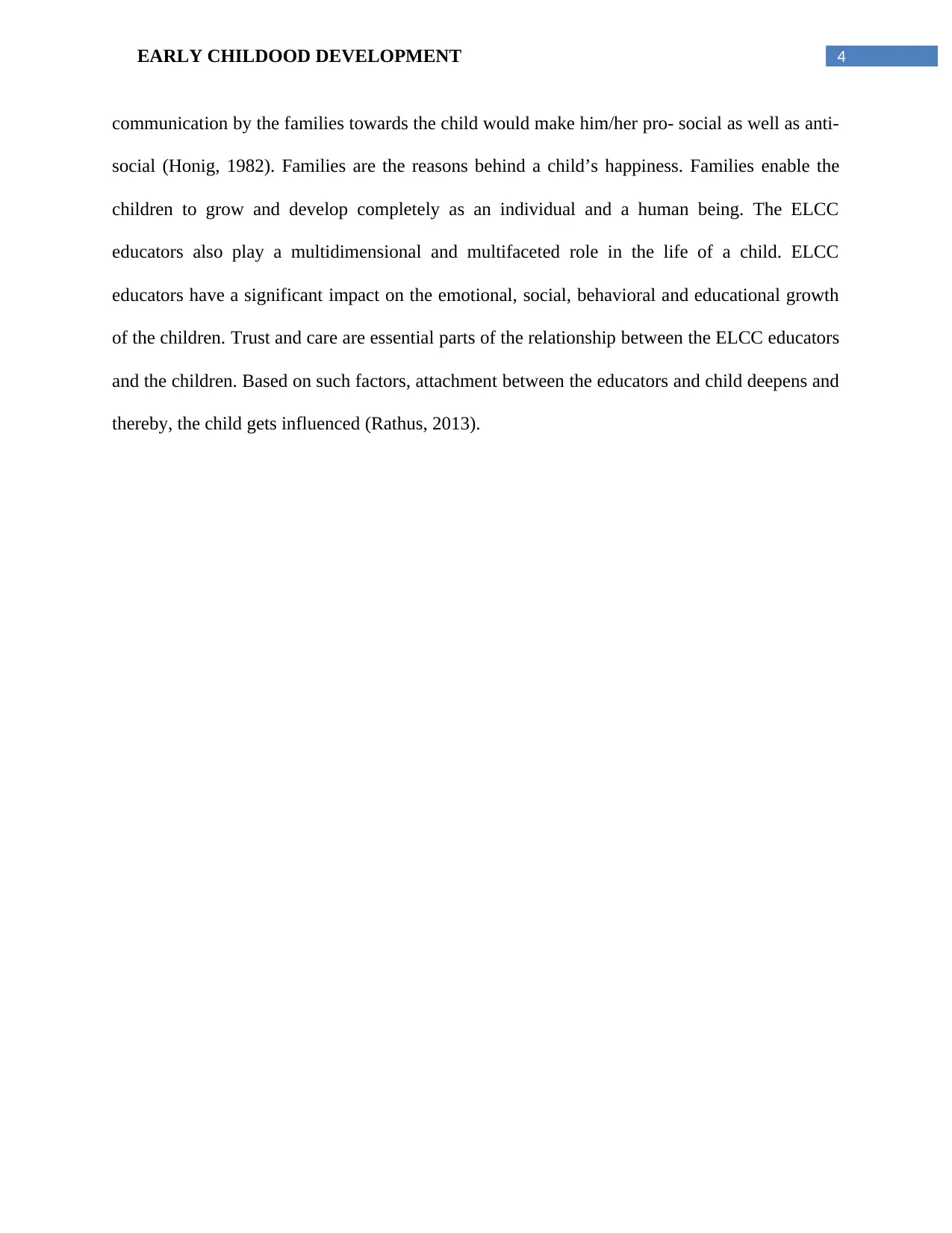
4EARLY CHILDOOD DEVELOPMENT
communication by the families towards the child would make him/her pro- social as well as anti-
social (Honig, 1982). Families are the reasons behind a child’s happiness. Families enable the
children to grow and develop completely as an individual and a human being. The ELCC
educators also play a multidimensional and multifaceted role in the life of a child. ELCC
educators have a significant impact on the emotional, social, behavioral and educational growth
of the children. Trust and care are essential parts of the relationship between the ELCC educators
and the children. Based on such factors, attachment between the educators and child deepens and
thereby, the child gets influenced (Rathus, 2013).
communication by the families towards the child would make him/her pro- social as well as anti-
social (Honig, 1982). Families are the reasons behind a child’s happiness. Families enable the
children to grow and develop completely as an individual and a human being. The ELCC
educators also play a multidimensional and multifaceted role in the life of a child. ELCC
educators have a significant impact on the emotional, social, behavioral and educational growth
of the children. Trust and care are essential parts of the relationship between the ELCC educators
and the children. Based on such factors, attachment between the educators and child deepens and
thereby, the child gets influenced (Rathus, 2013).
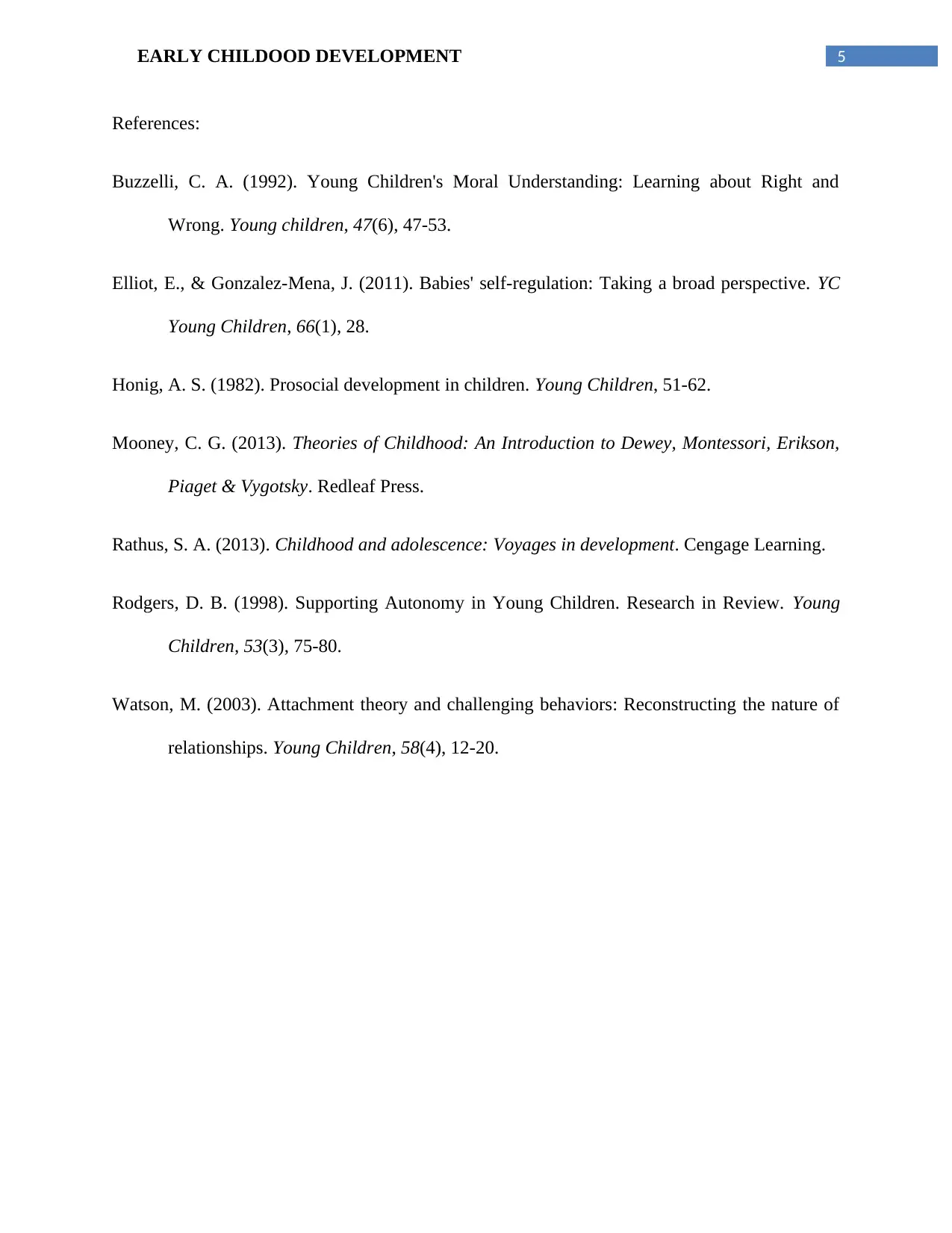
5EARLY CHILDOOD DEVELOPMENT
References:
Buzzelli, C. A. (1992). Young Children's Moral Understanding: Learning about Right and
Wrong. Young children, 47(6), 47-53.
Elliot, E., & Gonzalez-Mena, J. (2011). Babies' self-regulation: Taking a broad perspective. YC
Young Children, 66(1), 28.
Honig, A. S. (1982). Prosocial development in children. Young Children, 51-62.
Mooney, C. G. (2013). Theories of Childhood: An Introduction to Dewey, Montessori, Erikson,
Piaget & Vygotsky. Redleaf Press.
Rathus, S. A. (2013). Childhood and adolescence: Voyages in development. Cengage Learning.
Rodgers, D. B. (1998). Supporting Autonomy in Young Children. Research in Review. Young
Children, 53(3), 75-80.
Watson, M. (2003). Attachment theory and challenging behaviors: Reconstructing the nature of
relationships. Young Children, 58(4), 12-20.
References:
Buzzelli, C. A. (1992). Young Children's Moral Understanding: Learning about Right and
Wrong. Young children, 47(6), 47-53.
Elliot, E., & Gonzalez-Mena, J. (2011). Babies' self-regulation: Taking a broad perspective. YC
Young Children, 66(1), 28.
Honig, A. S. (1982). Prosocial development in children. Young Children, 51-62.
Mooney, C. G. (2013). Theories of Childhood: An Introduction to Dewey, Montessori, Erikson,
Piaget & Vygotsky. Redleaf Press.
Rathus, S. A. (2013). Childhood and adolescence: Voyages in development. Cengage Learning.
Rodgers, D. B. (1998). Supporting Autonomy in Young Children. Research in Review. Young
Children, 53(3), 75-80.
Watson, M. (2003). Attachment theory and challenging behaviors: Reconstructing the nature of
relationships. Young Children, 58(4), 12-20.
⊘ This is a preview!⊘
Do you want full access?
Subscribe today to unlock all pages.

Trusted by 1+ million students worldwide
1 out of 6
Related Documents
Your All-in-One AI-Powered Toolkit for Academic Success.
+13062052269
info@desklib.com
Available 24*7 on WhatsApp / Email
![[object Object]](/_next/static/media/star-bottom.7253800d.svg)
Unlock your academic potential
Copyright © 2020–2025 A2Z Services. All Rights Reserved. Developed and managed by ZUCOL.





